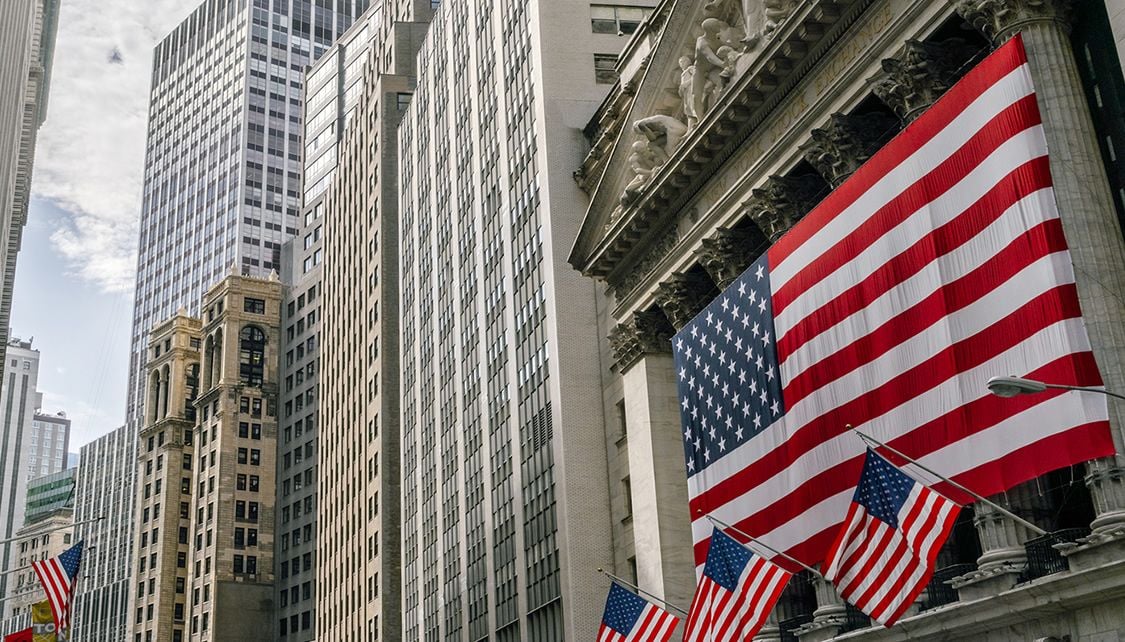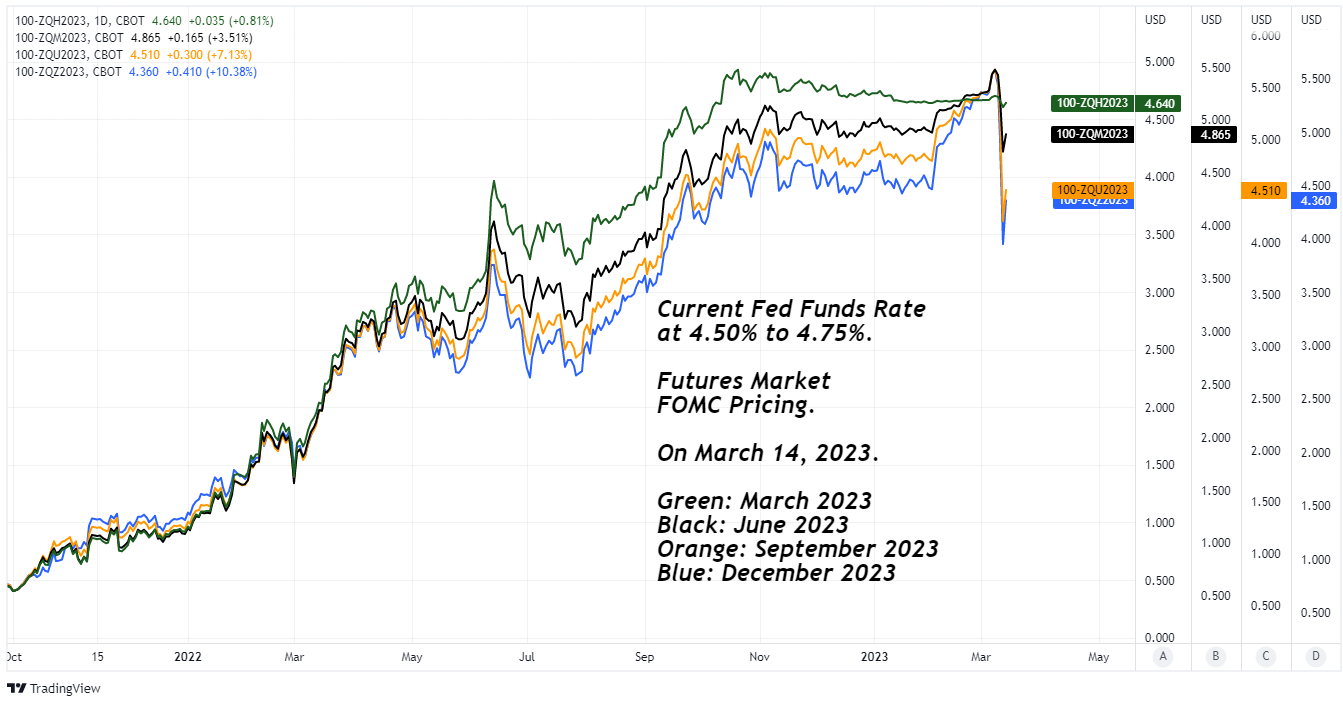U.S. Dollar and Fed Rate Outlook Post Bailouts: Analyst and Economist Views
- Written by: James Skinner
-

Image © Adobe Images
The high-profile failures of some small U.S. lenders and the resulting federal effort to prevent panic among depositors elsewhere have led financial markets to revise their outlooks for the Federal Reserve (Fed) interest rate while prompting analysts and economists to reconsider their forecasts.
Investors and traders have become divided over whether the Federal Reserve will raise its interest rate at all in March and the subsequent months since the weekend failure of Silicon Valley Bank and other small lenders in the U.S. prompted the market to write off its earlier outlook for borrowing costs.
Interest rate derivative markets were implying a high expected probability of the Fed raising the upper boundary of the Fed Funds rate range as far as 5.75% by year-end just one week ago but had by this Tuesday shifted to suggest that any further increase would likely be the last of this cycle.
Federal Funds rate futures still suggested on Tuesday a strong possibility of the Fed Funds rate being raised to between 4.75% and 5% following either the March or April meetings but were also banking on there being a high probability of cuts to the benchmark being announced no later than September.

This is despite Sunday actions from the U.S. Treasury, Fed and Federal Deposit Insurance Corporation (FDIC) intended to circumvent the kinds of conditions that could lead to so-called 'bank runs' elsewhere after concerns about the ready availability of customer deposits drove Silicon Valley Bank to failure.
But while a successful regulatory intervention can minimise or event prevent further institutional failures like those seen recently, many analysts and economists say the psychological shock and disruption involved is likely to restrict credit availability.
This is why some see the recent banking sector turbulence as likely to hamper the economy and have placed their forecasts for the Fed under review.
Below is a selection of excerpts setting out what various analysts and economists make of the recent events and how their outlooks have changed.
David Mericle, chief U.S. economist, Goldman Sachs
"We now expect the FOMC to pause at its March 21-22 meeting because we think Fed officials will worry that another interest rate hike could be counterproductive to efforts by US policymakers to shore up the financial system. It will be hard to be completely confident in the near term that Sunday’s intervention will halt the pressure on smaller banks, who play a large macroeconomic role and could become considerably more conservative in their lending."
"While we agree that more tightening will likely be needed to address the inflation problem if financial stability concerns abate, we think Fed officials are likely to prioritize financial stability for now, viewing it as the immediate problem and high inflation as a medium-term problem. We have left our Fed call beyond March unchanged and now expect a peak funds rate of 5.25-5.5%, though we see considerable uncertainty about the Fed’s path in March and beyond."
Bipan Rai, North American head of FX strategy, CIBC Capital Markets
"I received some pushback on my lower USD call from some corners. Look, I get it. A banking crisis should mean that the knee-jerk reaction is to buy USD via the safe haven effect. BUT – this completely looks past the fact that this is a US-specific problem right now."
"Not only that, the issue lies with a few regional US banks that weren’t subject to the same regulatory oversight that the larger ones were. Also (as mentioned above), US authorities have sent a CLEAR signal that they’ll do whatever it takes to keep depositors whole."
"That may eventually include pausing rate hikes, or stopping QT when it’s all said and done. Meanwhile, most reports suggest that the ECB sees little risk of contagion in the Eurozone and still appears to be on track to hike by 50bps later this week."
"Unless this metastases into a shock that crosses borders, I don’t see the case for a sustained haven bid to the USD."
Brad Bechtel, global head of FX, Jefferies
"We still have an inflation fight to win and Jay Powell will keep up the pressure on that front. Stuff is breaking, yes, but it was breaking already and that doesn't mean they just stop fighting inflation. Until the back of inflation is broken, there is no letting up on the fight."
"If more stuff starts breaking then we have a bigger issue, but the UK was able to wall off LDI and the Fed / UST seem to be able to wall off the regional banking crisis. We are still in the midst of it however, and so volatility will reign supreme for now."
"The GBP was the main driver yesterday with a fierce rally up through the 50dma that saw shorts squeezed and GBP crosses pressured higher. GBP/USD settled back above the 50 day moving average for the first time since early Feb and we are 1.2149 to open NY this morning. I still like holding a short here on this pair as the move just doesn't make sense to me."
"As we saw with the LDI issue in the UK, once the dust settles the market will revert pretty quickly and the central bank can get back to business. GBP/USD above the 1.2150 area is not where it should be if we get back on track."
Mark McCormick, global head of FX strategy, TD Securities
"The BTFP is a big deal but that does not mean that it will halt the initial market panic. Even if you believe that the SVB fallout and BTFP (to start) will ringfence the issue, market psyche will likely be skewed towards fading Fed hikes beyond March (or even March itself) even if strong CPI data surprises to the upside."
"The USD's sensitivity to FF [Fed] pricing has collapsed almost instanteously (and further out the curve). While the epicenter of the shock, we are reluctant to say that this is the negative inflection point for the USD."
"That said, we think it will broadly underperform in the short-term especially as its status as an equity vol hedge has eroded to the benefit of core FX. USDJPY and cross/JPY will remain biased to the downside, while CHF & MXN are sensitive to terminal repricing."
"While the emergency backstop announced by US regulators will likely prevent risk hemorrhaging, the USD is clearly on the backfoot for now, giving high USD beta EM FX a lift. A strong CPI print will limit the damage however, likely capping gains in EM FX vs. USD. We prefer higher yielding and higher USD beta EM."
Neil Wilson, chief market strategist, Finalto Trading & Markets.com
"If the Fed even pauses, let alone cuts, it’s inflation-fighting reputation will be in tatters. Market pricing is at evens for 25bps or a pause."
"We saw how the Bank of England was able to deliver emergency stimulus to prevent financial instability without disrupting its longer term monetary policy."
"It’s not clear whether the Fed will pause or not – they have a lot to do in tackling inflation still, but financial stability can often trump any other consideration as this can bleed into the wider markets and then onto Main St."
To optimise the timing of international payments you could consider setting a free FX rate alert$here.
Ian Shepherdson, chief economist, Pantheon Macroeconomics
"Modern economies are nothing without stable banks. The first role of the monetary authorities, therefore, is to ensure the integrity of the banking system."
"The Fed has a dual economic mandate, but that mandate is meaningless if the banking system breaks. It follows, then, that if policymakers conclude next week that a rate hike threatens the system, they will pass. Right now, though, it is not clear that the system is in peril."
Rates have risen rapidly, the money supply is shrinking, and response is fissures in some parts of the banking system. We have argued for some time that the Fed should stop raising rates, or at least pause to take stock of the impact of its tightening to date."
"Our case mostly has been based on the idea that pipeline inflation pressure is easing rapidly, even before the full effect of the Fed’s tightening is felt, but the banking developments make our core argument stronger."
Kit Juckes, chief FX strategist, Societe Generale
"The strongest currency since last Thursday is the Swiss franc, up 2% against the US dollar and 6% against the weakest (the Mexican peso)."
"This calm and understated reaction by the FX market may seem out of character to some but does reflect the uncertainty that we face and the very different FX implications of whether this proves to be a ‘Lehman moment’ or is simply further evidence that the US economy’s period of extraordinary growth is coming to an end as the Fed tightens policy. We are firmly in the latter camp, even if we acknowledge that uncertainty demands caution."
"The reason it matters for FX is– if SBVs woes cap Fed rate hikes, slow the US economy somewhat but not disastrously and don’t spread globally, the dollar is set to resume the downtrend it began at the end of September, which was interrupted by strong data in February. If on the other hand SBV was a canary in the global economy’s mine, the dollar will be stronger in a few months."
If you are looking to protect or boost your international payment budget you could consider securing today's rate for use in the future, or set an order for your ideal rate when it is achieved, more information can be found here.
John Velis, FX and macro strategist, BNY Mellon
"Yesterday (see here), we wrote that we still see a 25bp hike on the cards at next week’s FOMC meeting. Our reasoning is that the Fed has two sets of tools, intended for two different policy objectives. Setting up a backstop facility such as the BTFP allows the central bank to deal with financial stability issues, separating them from the Fed’s other function of setting monetary policy to deal with the dual mandate for employment and inflation."
"We view this seemingly contradictory set of policy moves much like what happened after turmoil hit the UK Gilt market this past September: the Bank of England stepped in to backstop the market (financial stability), even as it continued to hike policy rates (inflation goal)."
"None other than New York Fed President John Williams commented not too long ago that “using monetary policy to address longer-term financial stability considerations could come at a high cost in terms of current economic activity and could also undermine credibility in the central bank's long-run inflation goal.” Again, the implication is that there are two different policy tools to address two different objectives."
Chris Turner, regional head of research for UK & CEE, ING
"As markets continue to address the fallout of the SVB and Signature collapse and monitor US regional banks, a big question is emerging: will the Fed stop early? Markets are betting heavily it will, and this can mean a much weaker USD, but it’s not worth looking any further than the very short term for now. US CPI today will obviously have a much smaller impact."
"Market focus in the UK has been centred around HSBC’s purchase of SVB UK, an operation which was championed by the UK government. It is hard to draw any obvious conclusions from an FX perspective, especially in the current market environment where we could see large daily swings in equities driving a pro-cyclical currency like the pound."
